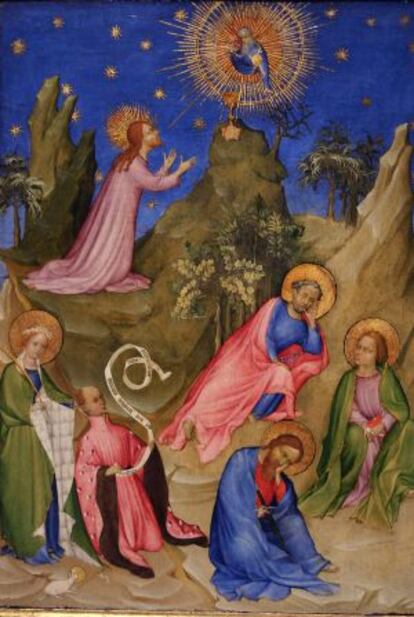Prado unearths French masterwork
With help from a nettle, museum adds rare 15th-century panel to collection

It wasn’t the x-ray, nor the infra-red analysis, but a stinging nettle that turned out to be the key to solving the mystery surrounding the 15th-century French panel painting The Agony in the Garden with the Donor Louis I d’Orléans.
Prado Museum restorer Pilar Silva was certain that the work, which had been unearthed in a private Spanish collection, was not just any old painting. More than that, she was just about convinced it was a piece made at the court of Louis I of Orléans (1372-1407). The female figure revealed in the lower left half after overpainting had been removed turned out to be Saint Agnes. And the French duke and regent had his reasons for asking the artist to paint her: both his father Charles V and his wife Valentina Visconti were devotees of the saint.
Uncovered alongside the woman, the enigmatic male figure dressed in a tunic in “the latest 15th-century fashion,” surrounded by golden nettles, had to be Louis I of Orléans, Silva concluded. Research led her to discover that the duke “had chosen that emblem, a heraldic symbol of the sting of death, at the same time as his disagreements with the Dukes of Burgundy (first with his uncle Philip the Bold and after with his cousin John the Fearless) were escalating, on a par with his political ambition.” In this way the patron could only be Louis, who was brutally murdered on the streets of Paris by his enemies.
“The Eureka moment in this story was the discovery of the nettles,” Silva says next to the restored 56.6 x 42 centimeter panel in room 51 A of the Prado, where it will remain on display until April 28.
Financed by the Iberdrola Foundation, María Antonia López de Asiaín spent over a year restoring the work in the museum’s workshop. The results of her labor can be clearly seen by comparing the finished painting with the photo next to it, showing its state after the museum purchased it at auction for 850,000 euros in 2011.
Its patron ended up being brutally murdered on the streets of Paris by his enemies
Nobody dared speculate how much the panel might be worth now its real importance is known at its unveiling on Monday. Only 10 or so panels from the same period with the same characteristics exist in the world. However, the museum’s associate director of curatorship and research, Gabriele Finaldi, said the Louvre recently paid seven million euros for a similar work, albeit one that was in a poorer condition.
It was Finaldi, who also played a key role in unearthing The Wine of Saint Martin’s Day by Pieter Bruegel the Elder in 2010, who first had faith the work might be more important than suspected, despite doubts from the likes of former Louvre director Michel Laclotte.
And the first x-ray analyses provided cause for optimism, showing that two figures had been painted out of the original composition. “It was probably done with a sale in mind. Perhaps they considered that the two figures sullied the purity of the religious scene,” says López de Asiaín.
After that, all that was remaining was to date the work and look for a possible artist. Prado experts hazarded it was probably painted between 1405 and 1408, just before or after the death of the man who commissioned it — don’t overlook the symbolism of the scene depicted: Christ saying his last prayers before being betrayed.
As for the artist, Silva had no option but to single out Colart de Laón (1377-1411). As well as the painting’s stylistic similarities with the artist’s known works, De Laón was painter to Louis I d’Orléans and inhabited the same building as the duke.
Tu suscripción se está usando en otro dispositivo
¿Quieres añadir otro usuario a tu suscripción?
Si continúas leyendo en este dispositivo, no se podrá leer en el otro.
FlechaTu suscripción se está usando en otro dispositivo y solo puedes acceder a EL PAÍS desde un dispositivo a la vez.
Si quieres compartir tu cuenta, cambia tu suscripción a la modalidad Premium, así podrás añadir otro usuario. Cada uno accederá con su propia cuenta de email, lo que os permitirá personalizar vuestra experiencia en EL PAÍS.
¿Tienes una suscripción de empresa? Accede aquí para contratar más cuentas.
En el caso de no saber quién está usando tu cuenta, te recomendamos cambiar tu contraseña aquí.
Si decides continuar compartiendo tu cuenta, este mensaje se mostrará en tu dispositivo y en el de la otra persona que está usando tu cuenta de forma indefinida, afectando a tu experiencia de lectura. Puedes consultar aquí los términos y condiciones de la suscripción digital.
Últimas noticias
The complicated life of Francesca Albanese: A rising figure in Italy but barred from every bank by Trump’s sanctions
From digital curfews to blocking apps: How technology experts protect their children online
Why the price of coffee has skyrocketed: from Brazilian plantations to specialty coffee houses
Confined to a Cuban hospital: When electricity is a matter of life or death
Most viewed
- Pablo Escobar’s hippos: A serious environmental problem, 40 years on
- Why we lost the habit of sleeping in two segments and how that changed our sense of time
- Trump’s obsession with putting his name on everything is unprecedented in the United States
- Charles Dubouloz, mountaineering star, retires at 36 with a farewell tour inspired by Walter Bonatti
- The Florida Keys tourist paradise is besieged by immigration agents: ‘We’ve never seen anything like this’









































